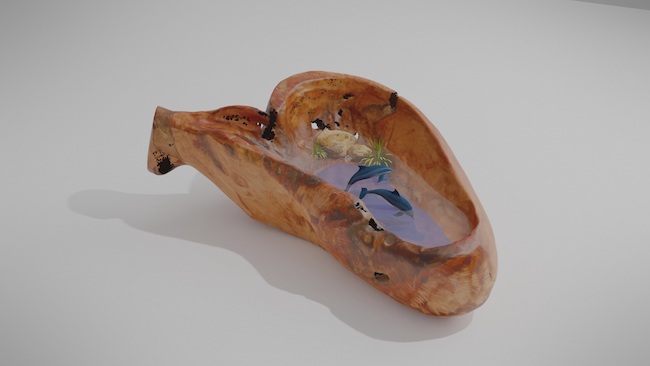L’approccio artistico legato alla materia, al modellare e a volte mescolare elementi plastici per dare vita alla realizzazione di tutto ciò che lo sguardo osserva e ammira è una caratteristica degli scultori di ogni secolo, sebbene le tecniche si siano modificate e l’aderenza alla realtà sia stata interpretata in maniera differente, se non addirittura eliminata come nel caso dei rappresentanti dell’Astrattismo. Il protagonista di oggi utilizza un mezzo innovativo, quello della progettazione in 3D, come base per sperimentare in maniera eclettica molteplici materiali e soggetti attraverso i quali misurarsi, di opera in opera.
Nel corso dei secoli precedenti al Ventesimo, la scultura ha rivestito un ruolo rilevante soprattutto per la sua capacità di interagire con l’ambiente circostante, quel trovarsi spesso in luoghi in cui le persone passavano ogni giorno dando così l’opportunità a chiunque di apprezzarne la bellezza e di comprenderne con immediatezza il messaggio. La celebrazione di gesta eroiche, di figure mitologiche o di personaggi importanti erano i temi comuni ai monumenti inseriti in contesti pubblici, il cui linguaggio doveva essere facilmente intuibile da chiunque li osservasse. Tuttavia alla fine del Diciannovesimo secolo in Inghilterra nacque un movimento artistico, denominato Arts and Crafts, in cui si delineò l’esigenza di rivalutare e dare nuova consistenza al lavoro artigianale, estendendo di fatto l’applicazione dell’arte e dunque della preziosità, a oggetti che abitualmente erano prodotti manifatturieri; la decorazione e realizzazione di pezzi che potessero entrare nelle abitazioni delle persone, unendo così l’utilità alla bellezza accessibile, furono le linee guida del movimento i cui appartenenti si misurarono dunque con oggetti come lampade, poltrone, tappeti, metalli, riprendendo di fatto il culto della preziosità di arnesi di uso comune che aveva contraddistinto le grandi civiltà del passato come quella egiziana, l’etrusca, la greca. L’innovazione fu non solo nello stile, che contraddistinse quello specifico movimento artistico denominato in maniera diversa in base al paese di appartenenza degli artisti aderenti, Modernismo in Spagna, Stile Liberty in Italia, Art Nouveau in Francia, bensì soprattutto nell’intento di trasformare in opera d’arte qualsiasi oggetto rendendolo unico, utilizzabile quotidianamente eppure in grado di costituire un elemento di arredo di forte impatto estetico. Tanto l’Arts and Crafts voleva combattere l’industrializzazione e la meccanizzazione, quanto nella contemporaneità i mezzi attraverso i quali poter generare opere d’arte sono in continua evoluzione, si avvalgono della tecnologia e dei computer per interagire direttamente con il talento espressivo dell’autore ma anche per completarlo dandogli modo di estendere la propria creatività o di generare, in alcuni casi, un modo inedito e diverso di entrare nel mondo dell’arte. È su questo nuovo terreno esplorativo che alcuni artisti contemporanei si muovono per strutturare in forma virtuale un’opera che poi completano manualmente, dando così vita a pezzi unici, con la loro forte impronta creativa, a volte attenendosi alla realtà osservata, altre invece stravolgendola per destabilizzare lo sguardo dell’osservatore, come nelle enigmatiche gigantesche installazioni di Anish Kapoor o le sculture di Tony Cragg e quelle destabilizzanti del cileno Sebastian Errazuriz.
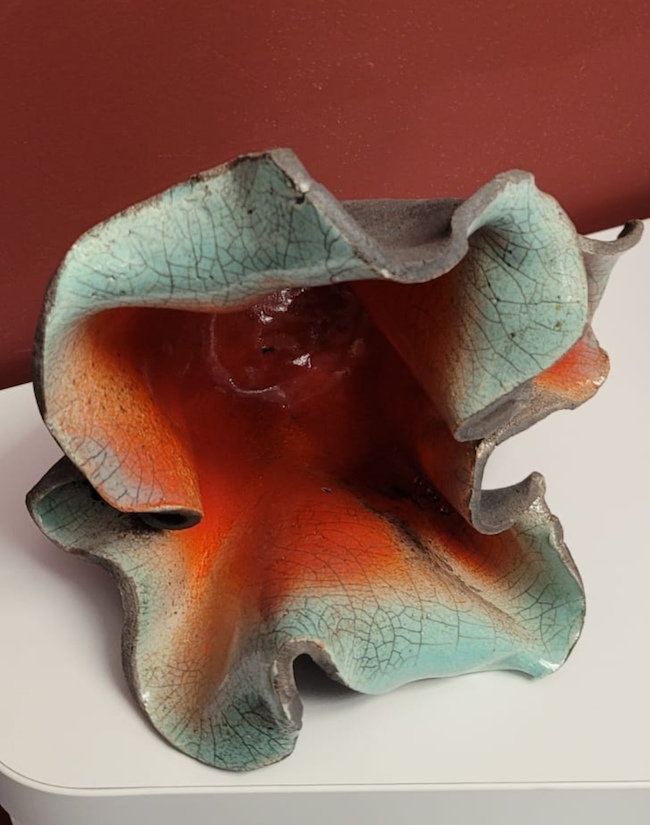
Gabriele D’Aloisio, imprenditore abruzzese che non riesce a lasciare inascoltato il suo forte lato creativo, associa l’intento originario dell’Arts and Crafts del realizzare oggetti in cui possa associare la sua tendenza espressiva a prodotti che mantengano un’utilità pratica e su cui può sperimentare le differenti materie con cui ama misurarsi perché in fondo ciascun’opera costituisce una sfida con se stesso, all’innovativa progettazione in 3D attraverso la quale studia le proporzioni e la scala di colori per poi proseguire con un approccio completamente manuale; attraverso la scultura riesce a incrementare e stimolare una curiosità innata e la possibilità di concretizzare l’ars faciendi che nella sua professione resta latente.

Il suo stile è assolutamente figurativo proprio perché il lato concreto dell’imprenditore lo conduce a osservare ciò che colpisce la sua attenzione, a dare ordine a ciò che lo sguardo vede, ricorda e poi concretizza riproducendolo per narrarlo nella sua pura bellezza, senza bisogno di distaccarsi dalla forma per enfatizzare il concetto bensì invitando l’osservatore a cogliere quei dettagli che nella quotidianità possono sfuggire. La tendenza a realizzare oggetti che possano entrare nelle case degli appassionati dando loro un’utilità pratica lo avvicina così all’intento dell’Arts and Crafts, sebbene se ne distacchi dal punto di vista formale perché abbandona quell’inclinazione romantica e floreale che contraddistinse gli artisti aderenti a quel movimento artistico.
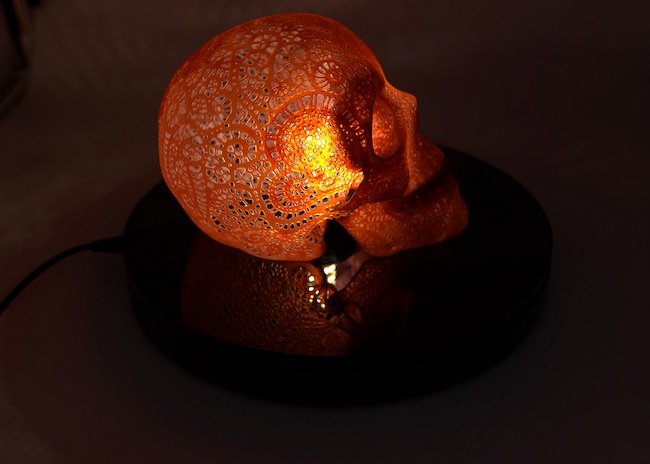
I materiali utilizzati da Gabriele D’Aloisio sono molteplici e spesso estremamente differenti tra loro per durezza e per duttilità, passa dai gessi al marmo, dal legno alla ceramica, dal metallo alle resine, dalla pasta di riso alle radici, tutti elementi che stimolano la sua espressività sulla base del soggetto che desidera raccontare, sia esso appartenente al mondo della natura sia che invece entri nell’ambito dell’immaginario; la lampada Teschio rappresenta dunque l’inclinazione di D’Aloisio a utilizzare instancabilmente arnesi attraverso cui concentra e unisce minuziosità e capacità rappresentativa, tanto quanto l’inclinazione a trasformare un’opera in oggetto che possa avere una sua vita, un’utilità che la rende quasi animata, presente nella quotidianità.
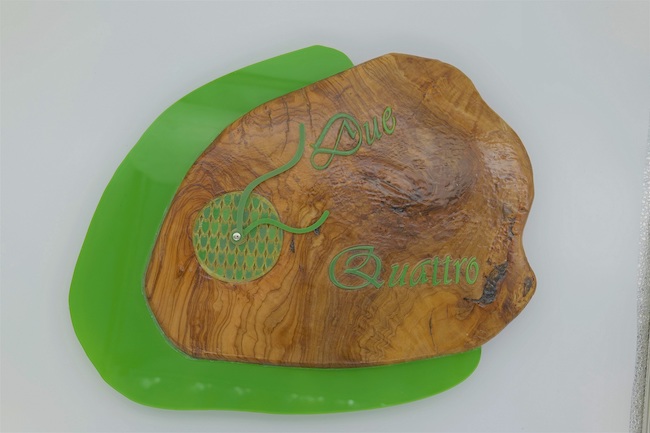
Così come l’orologio Foglia, nella sua singolarità e originalità formale, rappresenta il desiderio di uscire dalle regole, di sovvertire l’ordine di qualcosa di predeterminato, il tempo appunto, che scandisce l’esistenza senza che spesso si riesca a comprenderne la reale essenza; quell’aspetto deformato sembra voler sottolineare quanto sia importante non lasciarsi travolgere dall’impellenza che a detta le regole della vita, quel dover correre dietro gli impegni e le cose da fare senza essere capaci di lasciarsi andare e prendersi un momento per sé. Il fatto di inserire solo due numeri, il due e il quattro, sottolinea quanto sarebbe importante fare un passo indietro per prendere atto che tutto potrebbe essere fatto in maniera più lenta, più affine ai ritmi interiori, quelli della riflessione, del sentire, dell’ascoltare.
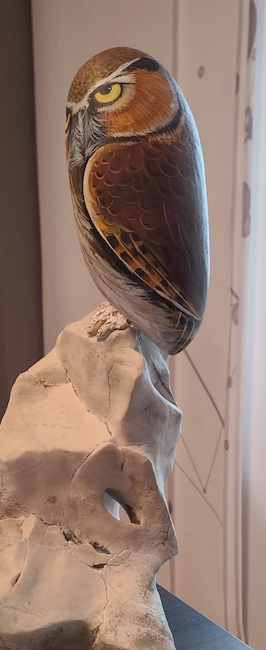
Il Gufo è invece una celebrazione della bellezza della natura, di quei dettagli che D’Aloisio sottolinea con colori ad acrilico e a olio in virtù dei quali riesce a infondere alla sua scultura la sembianza reale, generando nell’osservatore la sensazione che quell’animale stia vigilando sull’ambiente circostante, attento a ogni singolo movimento per decidere se restare o allontanarsi; la capacità realistica dell’artista si svela in maniera chiara in questa scultura in cui ogni dettaglio è fedelmente riprodotto, dal piumaggio allo sguardo del volatile, dalle zampe alla stessa posizione nella quale è comune scorgerlo anche nella realtà.
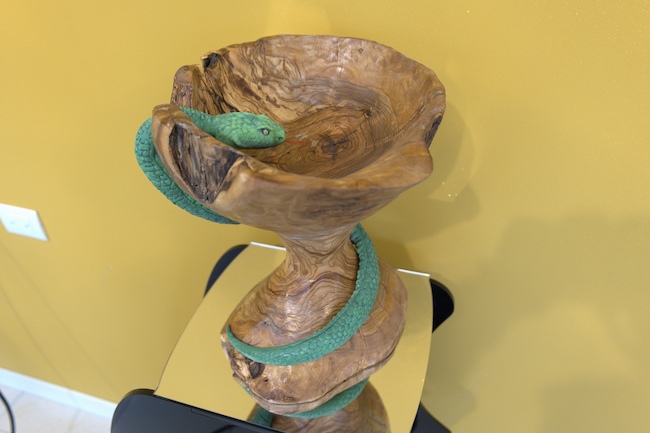
Nel vaso Serpente D’Aloisio pone in evidenza non solo il rettile in sé, bensì anche il simbolo controverso che esso rappresenta nella tradizione cristiana, in cui è associato da un lato associato alla tentazione ma dall’altro interpretato come salvezza dalle insidie, in contrapposizione con la religione ebraica dove è associato alla saggezza e con quella induista dove costituisce la sfida a conoscere il proprio lato oscuro per portarlo alla luce e trasformarlo in mezzo per raggiungere un nuovo equilibrio. Sembra esservi concentrata tutta la contraddittorietà dell’immagine del serpente nella scultura di D’Aloisio che di fatto si limita ad aprire la riflessione lasciando all’osservatore la possibilità di trarre la propria conclusione, e di avvicinarsi al senso che più è affine al proprio pensiero; l’esecuzione estetica è elegante, raffinata, descrive l’invertebrato nel momento in cui si avvolge al vaso e si insinua tra le sue curve, accostando nell’oggetto il legno alla ceramica. Dunque la base di partenza della proiezione in 3D si associa al suo gusto estetico e al desiderio di misurarsi con scalpelli, spatole e pennelli per dare un’immagine reale ma anche associata al suo pensiero, alla sua filosofia su alcuni aspetti del vivere contemporaneo. Gabriele D’Aloisio ha partecipato alla sua prima mostra collettiva nel 1992 poi però ha preferito continuare il suo percorso di ricerca artistica in solitaria e solo recentemente ha deciso di mostrare al pubblico le sue opere.
GABRIELE D’ALOISIO-CONTATTI
Email: dalogab@gmail.com
Facebook: https://www.facebook.com/gabriele.daloisio.7
Instagram: https://www.instagram.com/daloisiogabriele/
An unstoppable creative versatility in Gabriele D’Aloisio’s 3D sculptures
The artistic approach linked to matter, to modelling and sometimes mixing plastic elements to give life to the realisation of all that the eye observes and admires, is a characteristic of sculptors in every century, even though techniques have changed and adherence to reality has been interpreted differently, or even eliminated as in the case of representatives of Abstractionism. Today’s protagonist uses an innovative medium, that of 3D design, as a basis for eclectic experimentation with a variety of materials and subjects through which to measure himself, from artwork to artwork.
During the centuries prior to the twentieth, sculpture played an important role above all because of its ability to interact with its surroundings, that of often being in places where people passed by every day, thus giving anyone the opportunity to appreciate its beauty and understand its message with immediacy. The celebration of heroic deeds, mythological figures or important personalities were common themes for monuments placed in public contexts, whose language had to be easily understood by anyone observing them. However, at the end of the nineteenth century, was born in England an artistic movement called Arts and Crafts which outlined the need to re-evaluate and give new substance to craftsmanship, extending the application of art, and therefore of preciousness, to objects that were usually manufactured products; the decoration and creation of pieces that could be placed in people’s homes, thus combining usefulness with accessible beauty, were the guidelines of the movement, whose members therefore measured themselves with objects such as lamps, armchairs, carpets and metals, resuming the cult of the preciousness of everyday tools that had distinguished the great civilisations of the past such as the Egyptians, Etruscans and Greeks.
The innovation was not only in the style, which distinguished that specific artistic movement named differently according to the country of origin of the artists adhering to it, Modernism in Spain, Stile Liberty in Italy, Art Nouveau in France, but above all in the intention to transform any object into a work of art, making it unique, usable on a daily basis and yet able to constitute a furnishing element with a strong aesthetic impact. So much Arts and Crafts wanted to fight industrialisation and mechanisation, as much in contemporary times the means by which artworks can be generated are constantly evolving, making use of technology and computers to interact directly with the author’s expressive talent but also to complement it, giving him the opportunity to extend his creativity or to generate, in some cases, a new and different way of entering the world of art. It is on this new terrain of exploration that some contemporary artists move to structure a work in virtual form, which they then complete manually, thus creating unique pieces with their own strong creative imprint, at times adhering to the observed reality, at others distorting it to destabilise the observer’s gaze, as in the enigmatic gigantic installations of Anish Kapoor or the sculptures of Tony Cragg and the destabilising ones of Chilean Sebastian Errazuriz.
Gabriele D’Aloisio, an entrepreneur from Abruzzo who cannot let his strong creative side go unheeded, combines the original Arts and Crafts intention of making objects in which he can combine his expressive tendency with products that maintain a practical utility and on which he can experiment with the different materials he loves to measure because, after all, each work is a challenge for him, with innovative 3D design through which he studies the proportions and scale of colours and then continues with a completely manual approach; through sculpture, he manages to increase and stimulate an innate curiosity and the possibility of realising the ars faciendi that remains latent in his profession. His style is absolutely figurative because the concrete side of the entrepreneur leads him to observe what strikes his attention, to give order to what the eye sees, remembers and then makes concrete by reproducing it to narrate it in its pure beauty, without needing to detach himself from the form to emphasise the concept but inviting the observer to grasp those details that in everyday life may escape. The tendency to make objects that can enter the homes of art lovers, giving them a practical use, thus brings him close to the intent of Arts and Crafts, although he distanced himself from it from a formal point of view because he abandoned the romantic and floral inclination that distinguished the artists belonging to that artistic movement. The materials used by Gabriele D’Aloisio are varied and often extremely different from each other in terms of hardness and pliability, ranging from plaster to marble, from wood to ceramics, from metal to resins, from rice paste to roots, all of which stimulate his expressiveness on the basis of the subject he wishes to tell, whether it belongs to the world of nature or to the realm of the imagination; the Teschio (Skull) lamp thus represents D’Aloisio’s inclination to use tirelessly tools through which he concentrates and combines meticulousness and representative capacity, as well as his inclination to transform a work into an object that can have a life of its own, a usefulness that makes it almost animated, present in everyday life. Just as the Foglia (Leave) clock, in its singularity and formal originality, represents the desire to break the rules, to subvert the order of something predetermined, time, which marks existence without us often being able to understand its real essence; that deformed aspect seems to want to underline how important it is not to let ourselves be overwhelmed by the impellence that dictates the rules of life, that having to run after commitments and things to do without being able to let go and take a moment for ourselves.
The fact of including only two numbers, two and four, emphasises how important it would be to take a step back and realise that everything could be done more slowly, more in tune with our inner rhythms, those of reflection, feeling and listening. The Gufo (Owl), on the other hand, is a celebration of the beauty of nature, of those details that D’Aloisio emphasises with acrylic and oil paints by virtue of which he manages to imbue his sculpture with the semblance of reality, generating in the observer the sensation that the animal is keeping watch over its surroundings, attentive to every single movement to decide whether to stay or go; the artist’s realistic ability is clearly revealed in this sculpture in which every detail is faithfully reproduced, from the plumage to the bird’s gaze, from its legs to the same position in which it is commonly seen in reality. In the Serpente (Snake) vase, D’Aloisio highlights not only the reptile itself but also the controversial symbol it represents in the Christian tradition, where it is on the one hand associated with temptation but on the other interpreted as salvation from pitfalls, in contrast to the Jewish religion where it is associated with wisdom and the Hindu religion where it constitutes the challenge to know one’s own dark side in order to bring it to light and transform it into a means of achieving a new balance. All the contradictory nature of the image of the snake seems to be concentrated in D’Aloisio’s sculpture, which in fact merely opens up the reflection, leaving the observer to draw his own conclusion, and to approach the meaning that is closest to his own thoughts; the aesthetic execution is elegant, refined, describing the invertebrate as it wraps itself around the vase and insinuates itself into its curves, combining wood and ceramic in the object. So the starting point for the 3D projection is associated with his aesthetic taste and his desire to measure himself with chisels, spatulas and brushes to give a real image but also associated with his thought, his philosophy on certain aspects of contemporary living. Gabriele D’Aloisio took part in his first group exhibition in 1992 but then preferred to continue his artistic research on his own and only recently decided to show his works to the public.


